Systems pharmacology of mifepristone (RU486) reveals its 47 hub targets and network: comprehensive analysis and pharmacological focus on FAK-Src-Paxillin complex
- PMID: 25597938
- PMCID: PMC4297966
- DOI: 10.1038/srep07830
Systems pharmacology of mifepristone (RU486) reveals its 47 hub targets and network: comprehensive analysis and pharmacological focus on FAK-Src-Paxillin complex
Abstract
Mifepristone (RU486), a synthetic steroid compound used as an abortifacient drug, has received considerable attention to its anticancer activity recently. To explore the possibility of using mifepristone as a cancer metastasis chemopreventive, we performed a systems pharmacology analysis of mifepristone-related molecules in the present study. Data were collected by using Natural Language Processing (NLP) and 513 mifepristone-related genes were dug out and classified functionally using a gene ontology (GO) hierarchy, followed by KEGG pathway enrichment analysis. Potential signal pathways and targets involved in cancer were obtained by integrative network analysis. Total thirty-three proteins were involved in focal adhesion-the key signaling pathway associated with cancer metastasis. Molecular and cellular assays further demonstrated that mifepristone had the ability to prevent breast cancer cells from migration and interfere with their adhesion to endothelial cells. Moreover, mifepristone inhibited the expression of focal adhesion kinase (FAK), paxillin, and the formation of FAK/Src/Paxillin complex, which are correlated with cell adhesion and migration. This study set a good example to identify chemotherapeutic potential seamlessly from systems pharmacology to cellular pharmacology, and the revealed hub genes may be the promising targets for cancer metastasis chemoprevention.
Figures
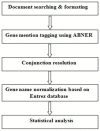

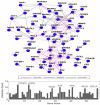
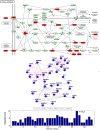

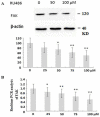
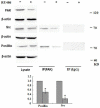
Similar articles
-
Focal adhesion proteins as markers of malignant transformation and prognostic indicators in breast carcinoma.Hum Pathol. 2006 Jan;37(1):9-15. doi: 10.1016/j.humpath.2005.09.024. Hum Pathol. 2006. PMID: 16360410
-
Retinoic acid induces nuclear FAK translocation and reduces breast cancer cell adhesion through Moesin, FAK, and Paxillin.Mol Cell Endocrinol. 2016 Jul 15;430:1-11. doi: 10.1016/j.mce.2016.04.021. Epub 2016 Apr 26. Mol Cell Endocrinol. 2016. PMID: 27130522
-
Activated Src increases adhesion, survival and alpha2-integrin expression in human breast cancer cells.Biochem J. 2004 Mar 1;378(Pt 2):559-67. doi: 10.1042/BJ20031392. Biochem J. 2004. PMID: 14629195 Free PMC article.
-
Integrin-regulated FAK-Src signaling in normal and cancer cells.Curr Opin Cell Biol. 2006 Oct;18(5):516-23. doi: 10.1016/j.ceb.2006.08.011. Epub 2006 Aug 17. Curr Opin Cell Biol. 2006. PMID: 16919435 Review.
-
The Role of Paxillin Aberrant Expression in Cancer and Its Potential as a Target for Cancer Therapy.Int J Mol Sci. 2023 May 4;24(9):8245. doi: 10.3390/ijms24098245. Int J Mol Sci. 2023. PMID: 37175948 Free PMC article. Review.
Cited by
-
Cancer metastasis chemoprevention prevents circulating tumour cells from germination.Signal Transduct Target Ther. 2022 Oct 2;7(1):341. doi: 10.1038/s41392-022-01174-w. Signal Transduct Target Ther. 2022. PMID: 36184654 Free PMC article. Review.
-
Drug Repositioning for Effective Prostate Cancer Treatment.Front Physiol. 2018 May 15;9:500. doi: 10.3389/fphys.2018.00500. eCollection 2018. Front Physiol. 2018. PMID: 29867548 Free PMC article. Review.
-
Overcoming Drug Resistance in Advanced Prostate Cancer by Drug Repurposing.Med Sci (Basel). 2022 Feb 18;10(1):15. doi: 10.3390/medsci10010015. Med Sci (Basel). 2022. PMID: 35225948 Free PMC article. Review.
-
The paradigm-shifting idea and its practice: from traditional abortion Chinese medicine Murraya paniculata to safe and effective cancer metastatic chemopreventives.Oncotarget. 2016 Apr 19;7(16):21699-712. doi: 10.18632/oncotarget.7932. Oncotarget. 2016. PMID: 26959747 Free PMC article.
-
Pharmacoproteomic analysis reveals that metapristone (RU486 metabolite) intervenes E-cadherin and vimentin to realize cancer metastasis chemoprevention.Sci Rep. 2016 Mar 2;6:22388. doi: 10.1038/srep22388. Sci Rep. 2016. PMID: 26932781 Free PMC article.
References
-
- Herrmann W. et al. Effects of an anti-progestin steroid in women: interruption of the menstrual cycle or early pregnancy (author's transl)]. Contracept Fertil Sex (Paris). 10, 389–393 (1982). - PubMed
-
- Chen J. Z. et al. The Unique Pharmacological Characteristics of Mifepristone (RU486): from Terminating Pregnancy to Preventing Cancer Metastasis. Medicinal Research Reviews. 34, 979–1000 (2014). - PubMed
-
- Lalitkumar S., Bygdeman M. & Gemzell-Danielsson K. Mid-trimester induced abortion: a review. Hum Reprod Update. 13, 37–52 (2007). - PubMed
-
- Winikoff B. Acceptability of medical abortion in early pregnancy. Fam Plann Perspect. 27, 142–148, 185 (1995). - PubMed
-
- Wu J., Liang Y., Nawaz Z. & Hyder S. M. Complex agonist-like properties of ICI 182,780 (Faslodex) in human breast cancer cells that predominantly express progesterone receptor-B: implications for treatment resistance. Int J Oncol. 27, 1647–1659 (2005). - PubMed
Publication types
MeSH terms
Substances
LinkOut - more resources
Full Text Sources
Other Literature Sources
Miscellaneous

